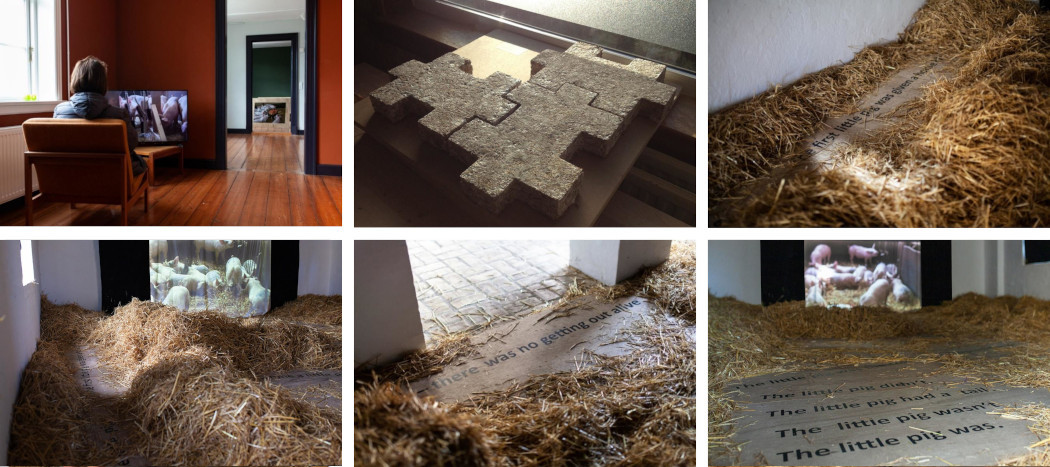Lille Gris was dreamt up before Brexit and Covid-19 changed everything. In December 2017 an invitation arrived to participate in an exhibition programme at the North Atlantic Lighthouse in Hanstholm, Denmark. This presented an ideal opportunity to open new dialogues on the welfare and intelligence of farmed pigs.
In our previous work, CARNEVALE, Cath Keay and I had designed sculptural playthings for pigs. Our aim was to highlight the ethical need to allow farm animals to play and alleviate boredom and problem behaviours among farmed pigs. We invited the writer Tessa Berring, to contribute to a newspaper we were publishing as part of the project, shown at the Roslin Institute. Tessa responded by writing Pig Dreams Pig Life and we paired this with images of pigs playing with the enrichment toys we had created.
The brief from Hanstholm Art Space was to make artwork on the relationship between man and nature and to engage with the local community. Our research involved creating a laboratory to grow chunky, edible, modular toys using a building material created from brewer’s mash combined with mycelium. The idea was to devise a source of food and enrichment for intensively reared pigs and to involve the stockperson in creating different toy structures for the pigs’ pens.
On a recce to Denmark in 2019, I visited three farms and met Trine, Bertel and Lasse and talked of pigs and their attributes. My impression was of these farmers leading the way in rearing pigs compassionately, enriching their lives with open space shelters, mud bathing and tree planting. They were incredibly knowledgeable on pig welfare and clearly cared deeply for their animals. It was amazing to see so many pigs outside, swinging and swizzling their tails. The Danish pig farmers were interested in the exhibition and a local brewery offered to supply beer in blank bottles, so Cath and I could apply our interactive labels. Then Covid struck.
Throughout 2020, making travel plans for both humans and artwork proved impossible. New exhibition dates were set for July 2021, so we needed to rethink the installation with the likelihood of not being able to travel to Denmark ourselves.
Tessa had written a new work, More Pig, which she recorded as a reading, and we designed the show around this. We took excerpts and created long strips of vinyl cut lettering, enlarged to 300pts to be read fixed directly on the floor:
The little pig was.
The little pig wasn’t.
The little pig had a tail.
The little pig didn’t.
The little pig was the colour of waterproof Elastoplast, pale and wipeable.
The workshop wing at the lighthouse had painted brick walls and a wooden beamed ceiling – it felt as if you were entering a barn. We projected footage of the Easter Howgate pigs snuggled deep in straw, to entice the viewer into the space. Stepping onto lines of vinyl text, the viewer was led around the room, pulled close to the walls to read more, and then taken back out of the door. The floor was covered in deep straw and the text was discovered by rooting. In another part of the lighthouse building, Tessa’s reading shared the space with images of pigs mounted on plywood boards. And CARNEVALE the newspaper was translated and printed in Danish.
There was an additional twist in this pig’s tale. The newspapers are still in transit, the plywood mounted prints never arrived in Hanstholm and were returned to Scotland unopened, along with an eye watering bill for taxes and duties. Transporting artwork to Denmark post-Brexit, mid-pandemic was we learnt, a whole different story…
We showed our work as part of Knowing Nature, an exhibition at Hanstholm Art Space (9th July-23rd August 2021) with artists Anne Bevan (UK) and Camilla Berner (DK).
Anne Bevan explores marine histories and contemporary environmental concerns through video, sculpture and temporary outdoor works. She presented work developed as part of an interdisciplinary project ‘Orkney: Beside the Ocean of Time’. Inspired by the late Orcadian writer and poet George Mackay Brown, the work explored the local shoreline of Stromness through different temporal and imaginary perspectives.
Camilla Berner uses yellow pollen gathered from Lodgepole pines in the Thy National Park. Lodgepole pine – Pinus contorta – is a pine tree imported from North America, introduced to Thy at the end of the 19th century, as sand drifts became a threat to farming in this area. The sand drift had resulted from an overexploitation of the land. The movement of sand was stopped, but over time Pinus contorta spread explosively and is now considered an invasive species in the area.
Photography © Cecilia Samsson / Andrea Roe
blogs.ed.ac.uk/equity-for-pigs/
For more work by Andrea Roe and Cath Keay, check out their brilliant project, CARNEVALE: what matters to pigs, 2017-18.
This is part of ROT, a section of The Learned Pig exploring multispecies creativity through modest tales of collaboration and coexistence amidst world-ending violence and disorder. ROT is conceived and edited by Julia Cavicchi.







